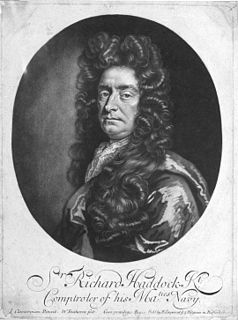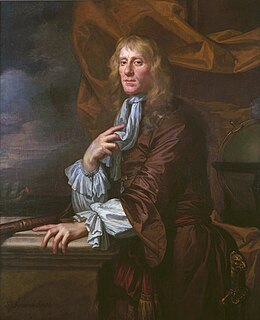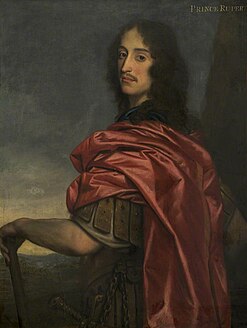
The Second Anglo-Dutch War, or the Second Dutch War was a conflict fought between England and the Dutch Republic for control over the seas and trade routes, where England tried to end the Dutch domination of world trade during a period of intense European commercial rivalry. After initial English successes, the war ended in a Dutch victory. It was the second of a series of naval wars fought between the English and the Dutch in the 17th and 18th centuries.

HMS Warrior is a 40-gun steam-powered armoured frigate built for the Royal Navy in 1859–1861. She was the name ship of the Warrior-class ironclads. Warrior and her sister ship HMS Black Prince were the first armour-plated, iron-hulled warships, and were built in response to France's launching in 1859 of the first ocean-going ironclad warship, the wooden-hulled Gloire. Warrior conducted a publicity tour of Great Britain in 1863 and spent her active career with the Channel Squadron. Obsolescent following the 1871 launching of the mastless and more capable HMS Devastation, she was placed in reserve in 1875, and was "paid off" – decommissioned – in 1883.

Admiral of the Fleet Edward Russell, 1st Earl of Orford, PC was a Royal Navy officer. After serving as a junior officer at the Battle of Solebay during the Third Anglo-Dutch War, he served as a captain in the Mediterranean in operations against the Barbary pirates.

Sovereign of the Seas was a 17th-century warship of the English Navy. She was ordered as a 90-gun first-rate ship of the line of the English Royal Navy, but at launch was armed with 102 bronze guns at the insistence of the king. It was later renamed Sovereign, and then Royal Sovereign. The ship was launched on 13 October 1637 and served from 1638 until 1697, when a fire burnt the ship to the waterline at Chatham.

The first HMS Shah was a 19th-century unarmoured iron hulled, wooden sheathed frigate of Britain's Royal Navy designed by Sir Edward Reed. She was originally to be named HMS Blonde but was renamed following the visit of the Shah of Persia in 1873.

The Royal Scots Navy was the navy of the Kingdom of Scotland from its origins in the Middle Ages until its merger with the Kingdom of England's Royal Navy per the Acts of Union 1707. There are mentions in Medieval records of fleets commanded by Scottish kings in the twelfth and thirteenth centuries. King Robert I, developed naval power to counter the English in the Wars of Independence (1296-1328), and after the establishment of Scottish independence continued to build up naval capacity. In the late fourteenth century naval warfare with England was conducted largely by hired Scots, Flemish and French merchantmen and privateers. King James I, took a greater interest in naval power establishing a shipbuilding yard at Leith and probably created the office of Lord High Admiral.
HMS Royal Oak was a 74-gun third rate ship of the line of the Royal Navy, built by Jonas Shish at Deptford and launched in 1674. She was one of only three Royal Navy ships to be equipped with the Rupertinoe naval gun. Life aboard her when cruising in the Mediterranean in 1679 is described in the diary of Henry Teonge.

Admiral of the Fleet George Legge, 1st Baron Dartmouth PC was an English naval commander who gave distinguished service to both Charles II and James II.
Bristol was a British 44-gun fourth-rate frigate, originally built for the navy of the Commonwealth of England during the 1650s. She was taken over by the Royal Navy after the Restoration of the monarchy in 1660, and was thereafter styled HMS Bristol. The ship participated in multiple battles during the Anglo-Spanish War of 1654–60, and the Second and Third Anglo-Dutch Wars.

Sir Edward Spragge was an Irish admiral of the Royal Navy. He was a fiery, brilliantly accomplished seaman who fought in many great actions after the restoration of King Charles II in 1660.

HMS Inconstant was an unarmored, iron-hulled, screw frigate built for the Royal Navy in the late 1860s. Upon completion in 1869, she was the fastest warship in the world and was assigned to the Channel Squadron. Two years later the ship was transferred to the Detached Squadron for a brief time before she was paid off into reserve in 1872. Inconstant was recommissioned in 1880 for service with the Flying Squadron that circumnavigated the world in 1880–82. On the return voyage, the ship was diverted to Egypt during the Anglo-Egyptian War of 1882 and played a minor role supporting operations ashore. She was reduced to reserve again after her return and was served as an accommodation ship in 1897. Inconstant was hulked in 1904 and became a training ship in 1906. She continued in that role, under a variety of names, until she was sold for scrap in 1955 and subsequently broken up, the second-to-last surviving Pembroke-built warship in existence.

HMS Royal Charles was a 100-gun first-rate ship of the line of the Royal Navy, designed and built by Sir Anthony Deane at Portsmouth Dockyard, where she was launched and completed by his successor as Master Shipwright, Daniel Furzer, in March 1673. She was one of only three Royal Navy ships to be equipped with the Rupertinoe naval gun.

HMS Royal James was a 102-gun first rate ship of the line of the Royal Navy, built by Anthony Deane at Portsmouth Dockyard at a cost of £24,000, and launched on 31 March 1671.

Prince Royal was a 55-gun royal ship of the English Royal Navy, built by Phineas Pett I at Woolwich and launched in 1610. The ship's fittings were carved by Sebastian Vicars, and painted and gilded by Robert Peake and Paul Isackson between Easter and Michaelmas 1611.

Sir Richard Haddock was an officer of the Royal Navy. He served during the Anglo-Dutch Wars, eventually rising to the rank of Admiral in August 1690. In Herge's Adventures of Tintin, Richard Haddock was one of the inspirations for Captain Haddock's 17th century ancestor, Sir Francis Haddock.

Admiral Sir Thomas Allin, 1st Baronet (1612–1685) was an officer of the Royal Navy who saw service in the English Civil War, and the Second and Third Anglo-Dutch Wars. A Royalist during the Civil War, he returned to service after the Restoration and eventually rose to the rank of Admiral after serving under some of the most distinguished military figures of the era, including Prince Rupert of the Rhine.
Richard Endsor is a British naval historian and maritime artist.

Sir Jeremiah Smith was an officer of the Royal Navy who saw service during the First and Second Anglo-Dutch Wars, rising to the rank of admiral.



















